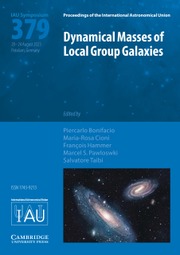Article contents
Magnetic Fields in the Milky Way Halo
Published online by Cambridge University Press: 05 March 2015
Abstract
We present a study of the Milky Way halo magnetic field, determined from observations of Faraday rotation measure (RM) of extragalactic radio sources (EGS) in Galactic longitude range 100°–117° within 30° of the Galactic plane. We find negative median RMs in both the northern and southern Galactic hemispheres for |b|>15°, outside the latitude range where the disk field dominates. This suggest that the halo magnetic field towards the outer Galaxy does not reverse direction across the mid-plane. An azimuthal magnetic field at heights 0.8−2 kpc above/below the Galactic plane between the local and the Perseus spiral arm can reproduce the observed trend of RM against Galactic latitude. We propose that the Milky Way could have a halo magnetic field similar to that observed in M51.
- Type
- Contributed Papers
- Information
- Proceedings of the International Astronomical Union , Volume 10 , Highlights H16: Highlights of Astronomy , August 2012 , pp. 403
- Copyright
- Copyright © International Astronomical Union 2015
References
- 1
- Cited by


